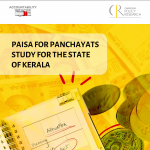
Mis-Management or Missing Management
1 January 1970
Over the last few years, India’s elementary education landscape has witnessed a lot of change. On the one hand, there has been a substantial increase in financial allocations. For instance, allocations for Sarva Shiksha Abhiyan (SSA) – the programmatic vehicle for elementary education have increased from Rs. 15,000 crores in 2010-11 to Rs. 25,555 crores in 2012-13. This represents an increase of 70 percent in 3 years. At the same time, with the passing of the Right to Free and Compulsory Education Act (RTE) in April 2010, states now have an increased responsibility towards the beneficiaries. Central and state governments can now be held accountable for failure of delivery.
So more resources and increased responsibility are being pushed into the system. But then the question arises – Is the architecture of elementary education equipped to handle it? Fundamentally, do we have the capacity and manpower to handle these changes?
So lets try and understand this with the help of a few examples….
1) Constraints at the Block Level
The Block is an essential component of the SSA structure for day-to-day support to teachers. The SSA organisational structures requires a Block Education Officer, responsible for supervision and monitoring of schools. In addition, the block has a Block Resource Coordinator (BRC), responsible for providing curricular support to teachers such as developing teaching learning materials. The BRCs are also expected to conduct workshops with subject teachers of upper primary classes and organise trainings.
However, a look at the number of vacancies across different states indicates a huge human resource deficit at the block level. As the table below indicates, at the end of 2011-12, there was a shortage of 60 BRC’s in Chhattisgarh, 192 in Haryana, 205 in Himachal Pradesh, 322 in Bihar and 353 in Maharashtra!
Interviews with officials in Medak district, also confirmed that 60 percent of posts for Mandal Education Officers (equivalent to BEO’s) are currently vacant.
Table 1
| State | Post Sanctioned | Post vacant |
| Maharashtra | 407 | 353 |
| Bihar | 537 | 322 |
| Himachal Pradesh | 301 | 205 |
| Haryana | 299 | 192 |
| Uttar Pradesh | 880 | 136 |
| Madhya Pradesh | 322 | 82 |
| West Bengal | 696 | 75 |
| Rajasthan | 244 | 69 |
| Jharkhand | 237 | 61 |
| Chhattisgarh | 150 | 60 |
2) Missing Junior Engineers: Example from Satara
The Junior Engineers (JE) are essential for the planning, designing and monitoring of all civil works – the second largest component of the SSA budget after teacher salaries. The roles and responsibilities of the JE include:
- Cross checking the school civil work requirements.
- Estimating the cost of the work on the basis of design specifications.
- Giving directions to the SMC on the layout and the work-estimates
- Monitoring the progress of the work
- Scrutinising the works to assess whether it meets the standards given the in the Public Works Department schedule of rates for building works
- And finally, assessing the work completion and expenditure and providing the completion certificate.
It is thus safe to say, the JE is one of the key implementing officers for any civil works project in schools. However, while analysing data for our district studies, we found that while the infrastructure budget for Satara, Maharashtra had increased by 61.6% between 2009-10 and 2010-11, the pace of activities at the school level was much slower. For example, allocations for boundary walls saw a massive jump from 0.88 lakhs to 210.9 lakhs, yet only 6.8 percent of schools had started construction. Similarly, only 15.2% schools had started toilet construction, despite an increase in allocations from Rs. 3.5 lakhs to Rs. 17.7 lakhs.
Interviews with officials solved part of the mystery – we found that more than half of required posts for JE’s were vacant in 2010-11. In fact, no infrastructure works could be carried out in one block as there were no JE’s in position. Satara is finally undergoing a huge recruitment drive to ensure this doesn’t happen this year.
A similar reason namely, “inadequate supervision staff” was cited in the Project Approval Board Meeting minutes as one of the main reasons for slow completion of civil works in Bihar.
3) School Management Committee Accountants – Example from Himachal Pradesh
The School Management Committee are an integral part of school functioning and decentralized decision making. According to the RTE, SMCs are mandated to monitor school functioning and develop annual school development plans (SDP). In addition, one of the most important tasks of the SMC’s is the management of finances. All monies related to basic school functioning (school grants) as well as infrastructure monies are transferred directly into SMC bank accounts at the school level. The SMC’s are thus responsible for maintaining passbooks and cashbooks and deciding and incurring expenditures at the school level.
Himachal Pradesh was a step ahead of most other states in that they were able to constitute their SMC’s by April 2010 (just after the passing of the Act). Moreover, in order to assist in the management of funds at the school level, Himachal Pradesh decided to appoint 1 accountant for 50 SMCs at the block level. However, one year after the implementation of the RTE, of the 303 accountants required, only 63 posts were filled by April 2011, leaving 240 posts vacant!! In addition, in Himachal Pradesh in 2011, the posts of a Finance controller at the state level and of 2 Finance and Accounts officers at the district level were also vacant.
Interestingly, while the budgets for SSA have increased substantially, the share of allocations for management (Block Resource Centres, Cluster Resource Centres, Management and MIS) have actually decreased. In 2009, allocations for management constituted 8 percent of the total SSA allocations. However, in 2011, this dropped to 7 percent. Moreover, even in terms of expenditure, in 2010, only 71 percent of management funds were spent, down from 78 percent in 2009-10.
These statistics clearly point to a great management challenge in SSA. Until we are able to staff and strengthen our management structures at every level of government – national, state, block, cluster and SMC – timely and efficient implementation of the programme will remain a challenge. One positive step has been the recognition of this constraint by the SSA Framework 2011. In fact, the framework stated “the project management structure and requirement of manpower, delegation and capacity building would have to be reviewed in light of the larger fund availability and considerable expansion of the activities of SSA in view of the RTE Act.” Now it’s time to move from theory to practice.





